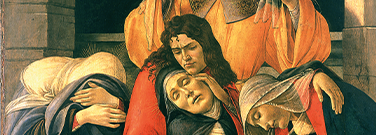Old Masters Used Eggs to Preserve Oil Paintings

By Celeste Beley
Art is often used to teach science, but what you may not realize is that science can explain a lot about art. We think of the Renaissance artists like da Vinci and Botticelli as geniuses with a paintbrush and canvas. As it turns out, they also needed to be savvy scientists. Their scientific techniques are what allow us to view their brilliant masterpieces today.
Until the 15th century, the dominant medium used by artists was egg tempera paint. Classical egg tempera is traditionally created by hand-grinding dry powdered pigments into a binding agent or medium, such as egg yolk, milk (in the form of casein), and plant gums.Renaissance-era painters replaced egg-based paints with oil-based paints as the dominant medium, but during the transition started using eggs mixed with oil-based paints. Why and how they continued to do this has been a mystery until now.
The Science Behind the Art
According to a paper published in Nature Communications, a team of researchers based in Germany and Italy have identified not only why the Old Masters would have added eggs to their paints but also how.
“The egg is used for modification and fine-tuning of paint properties,” said Patrick Dietemann, PhD, of the Doerner Institut in Germany and one of the co-authors of the paper. The team created two types of egg paint mixtures to experiment with: one consisted of pigment ground with linseed oil and a few drops of egg yolk and the second was comprised of pigment mixed with a solution of diluted egg yolk that was dried, ground, and dispersed with oil. They determined that changing the preparation technique enabled changes to the property of the paint.
In the first preparation, the team found that the paint could be made very stiff. This allowed the artist to apply heavy layers that do not spread, a technique known as impasto.
“In addition, the stiffness of the lower layers of paint prevents the paint surface from cracking or wrinkling during drying,” said Norbert Willenbacher, PhD, a co-author from the Karlsruhe Institute of Technology.
In the second preparation, the team discovered that humidity had less influence on the paint. “The yolk protects the paints from undesirable changes caused by absorption of moisture from the environment because the water is captured in the protein layer [surrounding the pigments],” noted Willenbacher.
The study revealed that adding egg yolk increased the drying time of paints due to its phospholipids and antioxidant properties, which also help protect from long-term oxidation and degradation.
Masterful Preservation
The researchers believed the artists made a very intentional choice to add eggs to their paints. “I am quite convinced that they did not know the chemical and physical explanations of what they were doing, but they knew very well what they were doing,” said Ilaria Bonaduce, analytical chemist at the University of Pisa and one of the study’s co-authors.
This just proves that a little bit of scientific experimentation can go a long way. Thanks to these accidental scientists, we can all still enjoy their masterpieces today.
Discussion Questions
- In what other ways do we use science to help protect and restore ancient artworks?
- Talk with an artist or art teacher. What other additives are mixed with paints to change the texture and why?